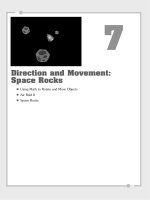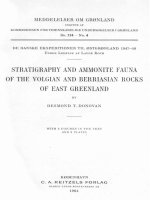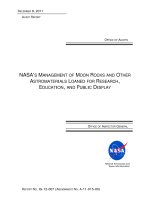Sedimentary rocks
Bạn đang xem bản rút gọn của tài liệu. Xem và tải ngay bản đầy đủ của tài liệu tại đây (8.27 MB, 38 trang )
THE LANGUAGE OF THE
EARTH – PART II
SEDIMENTARY
ROCKS
Principles
applied to
Sedimentary
Rocks
Uniformitarianism:
The Present is the Key
to the Past
Faunal Succession
Principles applied
to Sedimentary
Rocks
Original Horizontality
Superposition
Time
UNCONFORMITIES
“Looking into the Abyss
of Geological Time”
Siccar Point, Scotland
Definition
SEDIMENTARY ROCK - Compacted and cemented
accumulations of sediment, which can be of two
general types - clastic and chemical.
Clastic - composed of fragments of pre-existing rock
that have been weathered, eroded and transported
by wind, water, ice, or mass movement to a site of
deposition.
Chemical -composed of minerals precipitated from
water (usually ocean water) due to evaporation or
to the metabolic action of organisms (biogenic).
Sedimentary Rocks: Definition and General T
SEDIMENTARY ROCK - Compacted and cemented accumulations of
sediment, which can be of two general types - clastic and chemical.
Clastic - composed of fragments of pre-existing rock that have been weathered,
eroded and transported by wind, water, ice, or mass movement to a site of
deposition.
Chemical -composed of minerals precipitated from water (usually ocean water)
due to evaporation or to the metabolic action of organisms (biogenic).
Sediment
Sedimentary Rock
Clastic Sedimentary Rocks
Composed of fragments of pre-existing rock that
have been weathered,...
Mechanical Weathering
Clastic Sedimentary Rocks
Composed of fragments of pre-existing rock that
have been weathered,...
Chemical Weathering
Clastic Sedimentary Rocks
Composed of fragments of pre-existing rock that
have been weathered, transported...
by Ice (Glaciers)
Continental Glaciation
Till
Tillite
Clastic Sedimentary Rocks
Composed of fragments of pre-existing rock that
have been weathered, transported,...
by Water
The Work of Rivers –
Transport Sediment to the Sea
Mature Rivers –
Floodplains
and Meanders
4
Effects of
Changing
Base Levels
due to tectonic uplift
or changing sea level
Clastic Sedimentary Rocks
Composed of fragments of pre-existing rock that have
been weathered, transported,... by Wind
Cross-bedding
Clastic Sedimentary Rocks
Composed of fragments of pre-existing rock that
have been weathered, eroded, and transported
to a site of deposition
Deltaic Environments
deposition of sediment due to loss of transport energy
Near-shore Environments
of Deposition
Deep-water Deposition
Distinguishing Characteristics of Clastic Sediments:
Grain Size - mud/clay, silt (<0.06mm), fine sand (0.06-0.25mm),
coarse sand (0.25-2.0mm), pebbles (2-64mm), cobbles (64256mm), boulders (>256mm); particle size reflects energy
(velocity) of the transport and depositional system.
Distinguishing Characteristics of Clastic Sediments (cont.):
Sorting - Well-sorted sediment indicates prolonged reworking by wind or water; poorly
sorted sediment may indicate rapid deposition, or deposition by ice or mass movement.
Angularity/Roundness and Shape – Well rounded sediment also indicate prolonged
reworking by transporting agent; the shape of grains often indicates the transport
system, but also may be related to the type of mineral or rock fragment
Distinguishing Characteristics of Clastic Sediments (cont.):
Compositional Maturity - mature sediment contains only Quartz and Clay and reflects
prolonged weathering of the source rocks. Immature sediment contains other minerals
or rock fragments that may imply mostly mechanical weathering in the source region
and short transport distance.
Distinguishing Characteristics of Clastic Sediments (cont.):
Bedding/Stratification - Sediments transported by water and wind are typically bedded
(or stratified) due to fluccuations in the velocity of transport and sediment load.
Graded bedding is a gradual change from coarse particles at the base to fine particles at
the top of a bed that reflects a gradual decrease in the energy of the depositional
environment. Cross-bedding forms by dune migration in fluvial (stream), marine, or
eolian environments. Sediment transported by ice or mass movement are typically
unbedded (massive).
Lithification
Transformation of Sediment into Sedimentary Rock
Gravel
Compaction and Cementation of Clastic Sediments
Common Cementing Agents: Quartz, Calcite, Hematite
Conglomerate









